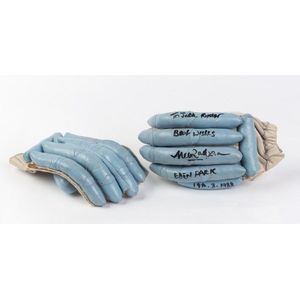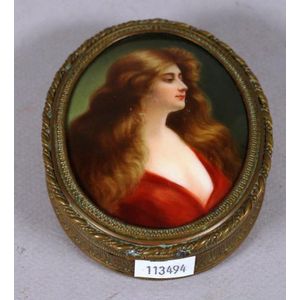18th Century Oak Cabinet on Stand
You must be a subscriber, and be logged in to view price and dealer details.
Subscribe Now to view actual auction price for this item
When you subscribe, you have the option of setting the currency in which to display prices to $Au, $US, $NZ or Stg.
- Fall Front - Furniture with a hinged flap, usually associated with desks and secretaires, that opens or 'falls' to provide a flat writing surface. The flap may be supported by chains or brass quadrants and rest on wooden supports or runners, known as lopers, that pull out from a recess in either side of the piece. The interior of a fall-front desk is usually fitted with small drawers and pigeonholes.
- Dentil Moulding - An architectural ornamental feature found on furniture, usually directly beneath the upper mouldings on a cornice. The timber is cut in a series of deep rectangular sections, alternatively raised and flat, like the crenellation on a castle battlement. In appearance not unlike a row of small teeth. From the latin "dens", teeth. Most commonly seen on bookcases, chests and cabinets, and less frequently on desks and wardrobes.
- Frieze - An architectural term denoting the flat, shaped or convex horizontal surface of furniture, between the architrave and the cornice, usually found on a cabinet or bookcase, or on desks and tables where it may include drawers, the area between the top and the legs. In ceramics, the term refers to the banding, of usually a repeating pattern, on the rims of plates and vases.
- Oak - Native to Europe and England, oak has been used for joinery, furniture and building since the beginning of the medieval civilisation. It is a pale yellow in colour when freshly cut and darkens with age to a mid brown colour.
Oak as a furniture timber was superceded by walnut in the 17th century, and in the 18th century by mahogany,
Semi-fossilised bog oak is black in colour, and is found in peat bogs where the trees have fallen and been preserved from decay by the bog. It is used for jewellery and small carved trinkets.
Pollard oak is taken from an oak that has been regularly pollarded, that is the upper branches have been removed at the top of the trunk, result that new branches would appear, and over time the top would become ball-like. . When harvested and sawn, the timber displays a continuous surface of knotty circles. The timber was scarce and expensive and was used in more expensive pieces of furniture in the Regency and Victorian periods. - Pad Foot - In furniture design, a pad foot refers to a type of
furniture foot that is shaped like a flattened ball or pad. It is a common
design element in traditional furniture styles, particularly in English and
American furniture from the 18th and 19th centuries. The pad foot is typically
wider than it is tall, with a broad, flat surface that rests directly on the
floor. It is often carved or turned with decorative details, such as fluting or
ridges, and can be made from a variety of materials, such as wood, metal, or
leather.
Pad feet are used to support the legs of various types of
furniture, such as chairs, tables, and cabinets. They are often used in
combination with other types of feet, such as bun feet or bracket feet, to
create a more complex and decorative furniture design. In terms of
functionality, pad feet provide stability and support to furniture pieces, and
can help distribute the weight of the piece evenly across the floor. In terms
of design, they add a classic and traditional look to furniture designs, and
are often used to create a sense of elegance and refinement. - Apron - A decorative wooden panel that sits underneath the top surface of a table or chair, and unites the top of the piece with the legs, running at right angles to the underside. On carcase furniture such as a chest or wardrobe, the apron sits below the drawers or doors and attaches to the legs.
On carcase furniture without legs the panel under the drawers or doors sits on the floor and is termed a plinth.
An apron can provide a decorative touch to an otherwise unadorned piece of furniture and at the same time provide structural support and strength. They can be carved or pierced and quite elaborate. - Cornice - The upper section of a high piece of furniture such as a bookcase, wardrobe or cabinet that sits immediately on the main structure. The cornice is usually decorated with a variety of architectural mouldings, worked either with a moulding plane or, from the later 19th century, by machine. The front and side of the cornice are mitred together, strengthened by glue blocks, and the back is generally a simple dovetailed rail to hold the structure together. Cornices are generally, though not always, fitted separately to the piece and are held in place either by screws sunk into the top board or by wooden corner blocks. A pediment may sit above the cornice, but sometimes the terms cornice and pediment are used interchangeably.
- Cabriole Leg - The cabriole leg evolved from an elongated scroll, curving out at the knee which may or may not be carved, and forming a serpentine shape as it descends to the foot.
First introduced into English furniture in the late 17th century, cabriole legs were widely used during the Queen Anne and early Georgian periods, where they frequently terminated in a pad foot or ball and claw foot. The style has had many imitators since then. The cabriole leg was re-introduced in the mid-19th century, and is commonly associated with the balloon-back dining or drawing-room chairs made in walnut, mahogany or, in Australia, cedar. The Victorian cabriole leg, on the whole, was rather more slender than the earlier form, following the French style, which emphasized the delicacy and daintiness of the chairs they were designed to support. Cabriole legs are sometimes found on windsor chairs, especially those made during the 18th century.
This item has been included into following indexes:
Visually similar items

Neal Radford's England Odi batting gloves, pair of match-used gloves, one signed & endorsed 'Eden Park, 19th.3.1988'. [Neal Radford played 3Tests & 6 ODIs 1986-88].

A Pique pendant, the oval tortoiseshell pendant inlaid with gold and silver

Vintage porcelain lidded trinket box, porcelain lid with portrait of a woman, to metal box, with lined interior (worn). Height 10 cm

Two Xylonite boxes with manicure tools. (qty)
